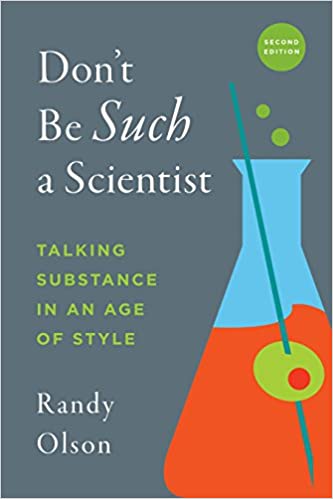
Storytelling Tips from Don't Be Such A Scientist
 Storytelling is vital to successful science communication. However, our inner scientist can often get in the way of telling a good science story. I read Don’t Be Such a Scientist by Randy Olson to learn more about what I can do to improve my storytelling.
Storytelling is vital to successful science communication. However, our inner scientist can often get in the way of telling a good science story. I read Don’t Be Such a Scientist by Randy Olson to learn more about what I can do to improve my storytelling.
“Narrative is everything.”
We tell stories with our data in papers, posters, and talks in addition to outreach; thus, science needs storytelling skills. One important skill is narrative: the basic problem-solution dynamic that gives a story structure. For example, take the hero’s journey: the hero lives in a wonderful world and is happy but a problem arises, therefore she goes on a journey to solve the problem. This narrative can be broken into the “ABT” method Olson developed.
The “A” is for “And.” The hero lives in a wonderful world AND is happy. In science, this is the background where we list relevant facts. Taking my research as an example, we know that fibroblast growth factor signaling is important for the development of vertebrates AND has roles in cancer, especially ovarian cancer AND it may be important for gonad development.
The “B” is for “But.” The hero lives in a wonderful world and is happy BUT a problem arises. This is the research question and can potentially contradict what’s known in the field. We know all these facts about fibroblast growth factor signaling, BUT what is its actual role in gonad development?
The “T” is for “Therefore.” The hero lives in a wonderful world and is happy but a problem arises, THEREFORE she goes on a journey to solve the problem. This is the results section and the conclusion, or consequence, of your work. What are all the experiments that you did and what did you conclude from them? For me, I know all these facts about fibroblast growth factor signaling, but we’re investigating its role in gonad development, therefore I am using a variety of experiments to examine whether certain aspects of the pathway are necessary for proper development.
This is a very brief outline of how to use this technique, and there are other ways of adding narrative to your science. We took a deeper dive into storytelling in our March 2020 workshop led by Mary Madera, where we shared tips on narrative like having a relatable main character. Despite seeming so simple, developing a good narrative is difficult, and there are several obstacles we face as a result of our scientific training.
Obstacles to narrative
The obstacles are broken down in depth in different chapters, which I highly recommend reading for yourself. Olson describes that oftentimes scientists give presentations that are all substance and no style, also known as the “what” and the “how.” As scientists, we nail the “what” but struggle with style in our delivery. He suggests introducing spontaneity to increase the energy of a presentation. To find spontaneity, try out some improvisation theater (improv) classes! We hosted an improv workshop in February 2020 with Lucas Hatton.
When incorporating style, it is important to keep in mind the delicate balance between accuracy and boredom. As scientists, accuracy is vital and we strive to be as accurate as possible in our communication. In outreach, we can accurately list facts — And, And, And — but this is boring and ineffective. The public is not trained the same as we are to interpret facts and data to come to a conclusion.
So how do we go about being accurate without “dumbing down” (assuming our audience is incapable of understanding) our science? I’ve never heard or read an answer quite as good as Olson’s:
“[Concision]means conveying a great deal of information using the fewest possible steps or words or images or whatever the mode of communication is. [Dumbing down] results in a dull, shallow presentation; [concision] is a thing of beauty that can project infinite complexity.”
This demonstrates that we can be accurate, concise, and have style all at once.
How can I apply these to my own science communication?
With practice! Practice constructing a 1–2 minute elevator pitch about your research for different audiences. Here’s the example Olson gave in the book:
“I study the one species of starfish that spawns in the dead of winter instead of during the vibrant spring.”
Here’s mine:
“I study how reproductive organs grow in fish because some of these mechanisms are associated with ovarian cancer.”
It tells a story, and while it doesn’t give the conclusion away, it piques enough interest to prompt questions or be memorable.
Practice on friends and family or during class and lab presentations. Practice a written piece with us (send us a pitch at davissciencesays@gmail.com). Get inspiration from great science communicators like the late Carl Sagan, Neil deGrasse Tyson, Siddhartha Mukherjee (author of The Gene), Carl Zimmer (author of She Has Her Mother’s Laugh), and Ed Yong (science writer for The Atlantic). And don’t forget to have fun crafting your story.
Here’s how I wrote this article using ABT:
Science communication needs storytelling AND narrative AND you can use “ABT” to incorporate narrative BUT we face obstacles as scientists, THEREFORE we must be aware of them when we communicate our work.
Sydney Wyatt is a PhD student at the University of California in Davis. For more content from the UC Davis science communication group "Science Says", follow us on Twitter @SciSays.

Comments